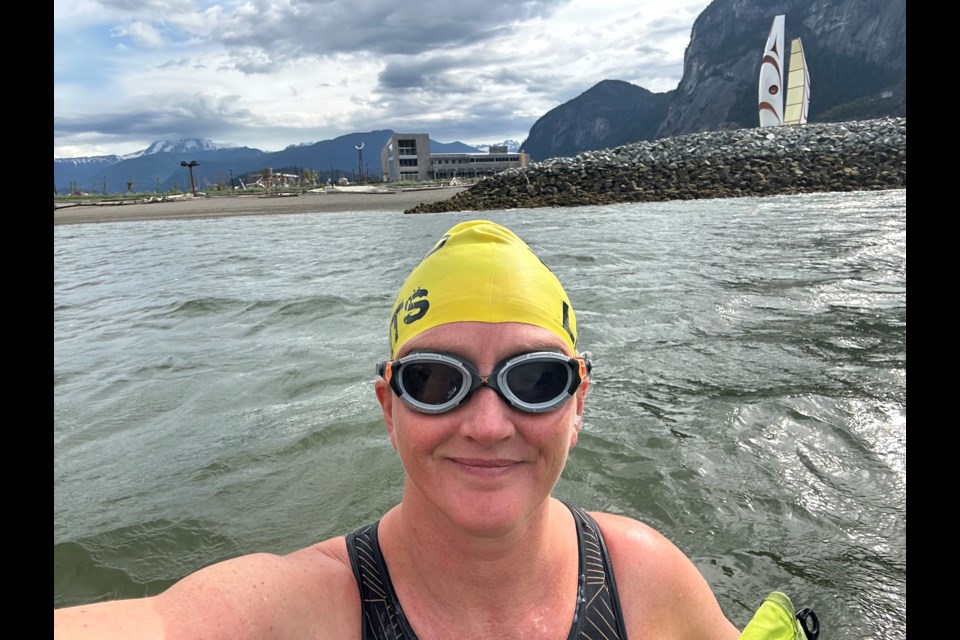Many people drive along the Sea to Sky Highway, but most probably wouldn’t consider swimming alongside it.
But that is just what Vancouver lifeguard and distance ocean swimmer, Jessi Harewicz plans to do as she embarks on a challenging swim from ÃÛÌÒÊÓƵappto Horseshoe Bay.
Setting off during the tidal window between June 8 and 10 at around 2 a.m. Harewicz will complete the 30 km journey in approximately 12 hours.
And the motivator for the challenge—besides the love for the sport— is to raise funds for the in Squamish.
"It’s taken a few years … but I understand why nobody wants to swim big distances in Howe Sound. There’s lots of planning and logistics. Lots of little islands placed close together with some crazy wind patterns and currents," Harewicz said in a press release.
"[But] the snow-capped mountains, the Indigenous stories, driftwood, the seals and other wildlife, make it a place to swim like no other."
Harewicz told The ÃÛÌÒÊÓƵapp that her love for open water swimming blossomed in 2016 following a diagnosis of a degenerative hip impingement.
After attending a swim camp with a number of athletes who had completed the English Channel (a 33-kilometre or 20.5-mile swim between England and France) she set her sights on completing the iconic journey herself.
“Back then, if you wanted to do anything around 10 km, you all went to the same camp, and I got exposed to all these English Channel people, and I was in a wetsuit, and there were all these people swimming without wetsuits,” she said.
“And I was like, ‘What is this? I don't understand’ and they kind of just brainwashed me into this whole thing about ... if you can tough [the cold temperature] out, you can swim the English Channel.”
Well, by 2017, she did exactly that, completing the marathon swim in 17 hours and 34 minutes.
In August of 2022, Harewicz became the first Canadian to swim the North Channel (between Northern Ireland and Scotland).
She also holds the record for the longest unassisted (no wetsuit or touching the boat) ocean swim in the Salish Sea—a 30-hour, 58 km swim from Nanaimo Harbour to Kitsilano Beach, which she completed in 2019.
And just last year, she took on the width of Lake Ontario, a whopping 51km distance to raise money for the
The swim
Harewicz said that the route she’s chosen, from ÃÛÌÒÊÓƵappto Horseshoe Bay, was inspired by fellow English Channel swimmer Shane Collins, who passed away in 2017.
“He actually did this route first,” she said.
“I remember we talked about it briefly when I was training for the English Channel and he was like ‘Oh, it is so cold, it's the coldest swim I've ever swam,’ and when I started looking at things like the North Channel … I started looking at colder swims, and this swim just kept coming back in my head and I thought—we can do this.”
The swim makes up part of Harewicz’s Átl'ḵa7tsem/Howe Sound Swimming Project in which she aims to create a comprehensive swim map for fellow swimmers and outdoor enthusiasts.
“Since [Howe Sound] also got named a [UNESCO] Biosphere within the time that I've been swimming there, [I want] to do as many routes as I physically can within the biosphere,” she said.
But it won’t be an easy feat.
“This route is a hard route. This is going to be tough because it's a big, big change in temperatures throughout the route,” she said.
“There are spots along the highway that are on the way to ÃÛÌÒÊÓƵapp[where it’s] 13 C. And then you go up into the rivers, and they're six or seven.
“Even half a degree Celsius, to one degree Celsius of water temperature change, if you're not wearing wetsuits, and even if you're conditioned like I am, is a big difference. So every degree is a big deal.”
As an advocate for safe open water recreation, Harewicz is always keen to promote trip planning as she knows all too well how conditions can change quickly.
“We have four people on a boat watching one person, [because it can be] very dangerous,” she said.
Her support boat will follow her throughout the swim and a live track will be available for people to follow her adventure.
“Hopefully, people understand that this … is my choice, and I'm not putting anybody else in danger or trying to accomplish something that's difficult,” she said.
Why RCM-SAR?
Advocating for safe swimming means recognizing that sometimes, people aren’t always safe while partaking in water sports, and sometimes those people need to be rescued.
“We have these resources out there to save people, and there are amazing experiences, both on the mountains and water, but we have to respect nature,” Harewicz said.
“I'm so lucky to have my own support and family support that we are able not to use [RCM-SAR]. But it's really important that we raise awareness and much more money for these organizations, because as water sports do increase in popularity, some people are safe, some people are not so safe. And we need these resources at our fingertips.”
RCM-SAR Station 4 leader Rob Walter said in the press release that he was “incredibly thankful” Harewicz was using her swim to help raise funds for the organization.
"As a fully volunteer crew, it's only through the kind donations of local individuals and businesses that we're able to support our community year-round,” he said.
To donate to Harewicz’s campaign, visit the and follow along her journey via



